Version history
The following tables show the release dates and key features of all Android operating system updates to date, listed chronologically by their official application programming interface (API) levels.
Android 1.0
| Android 1.0 (API 1) | ||
|---|---|---|
| Android 1.0, the first commercial version of the software, was released on September 23, 2008.[29] The first commercially available Android device was the HTC Dream.[30] Android 1.0 incorporated the following features: | ||
| Version | Release date | Features |
| 1.0 | September 23, 2008 |
|
Android 1.1
| Android 1.1 (API 2) | ||
|---|---|---|
| On February 9, 2009, the Android 1.1 update was released, initially for the HTC Dream only. Android 1.1 was known as "Petit Four" internally, though this name was not used officially.[12][37] The update resolved bugs, changed the Android API and added a number of features:[38] | ||
| Version | Release date | Features |
| 1.1 | February 9, 2009 |
|
Android 1.5 Cupcake
| Android 1.5 Cupcake (API 3) | |||
|---|---|---|---|
| On April 27, 2009, the Android 1.5 update was released, based on Linux kernel 2.6.27.[39][40] This was the first release to officially use a codename based on a dessert item ("Cupcake"), a theme used for all releases until Android Pie, with Android 10 and later using a number-only system. The update included several new features and UI amendments:[41] | |||
| Version | Release date | Features | Image(s) |
| 1.5 | April 27, 2009[39] |
|  Android 1.5 home screen |
Android 1.6 Donut
| Android 1.6 Donut (API 4) | |||
|---|---|---|---|
| On September 15, 2009, Android 1.6 – dubbed Donut – was released, based on Linux kernel 2.6.29.[44][45][46] Included in the update were numerous new features:[44] | |||
| Version | Release date | Features | Image(s) |
| 1.6 | September 15, 2009[45] |
|  Android 1.6 home screen |
Android 2.0 Eclair
| Android 2.0 Eclair (API 5) | |||
|---|---|---|---|
| On October 27, 2009, the Android 2.0 SDK was released, based on Linux kernel 2.6.29 and codenamed Eclair.[47] Changes include the ones listed below.[48] | |||
| Version | Release date | Features | Image(s) |
| 2.0 | October 27, 2009[49] |
| |
Android 2.0.1 Eclair
| Android 2.0.1 Eclair (API 6) | |||
|---|---|---|---|
| Version | Release date | Features | Image(s) |
| 2.0.1 | December 3, 2009[53] |
| |
Android 2.1 Eclair
| Android 2.1 Eclair (API 7) | |||
|---|---|---|---|
| Version | Release date | Features | Image(s) |
| 2.1 | January 11, 2010[54][18] |
|  Android 2.1 home screen |
Android 2.2 Froyo
| Android 2.2 Froyo (API 8) | |||
|---|---|---|---|
| On May 20, 2010, the SDK for Android 2.2 (Froyo, short for frozen yogurt) was released, based on Linux kernel 2.6.32.[55] | |||
| Version | Release date | Features | Image(s) |
| 2.2 | May 20, 2010 |
|  Android 2.2 home screen |
| 2.2.1 | September 27, 2010[63] |
| |
| 2.2.2 | January 21, 2011[64] |
| |
| 2.2.3 | November 21, 2011[66] |
| |
Android 2.3 Gingerbread
| Android 2.3 Gingerbread (API 9) | |||
|---|---|---|---|
| On December 6, 2010, the Android 2.3 (Gingerbread) SDK was released, based on Linux kernel 2.6.35.[67][68] Changes included:[67] | |||
| Version | Release date | Features | Image(s) |
| 2.3 | December 6, 2010[68] |
|  Android 2.3 home screen |
| 2.3.1 | December 22, 2010[71] |
| |
| 2.3.2 | January 21, 2011[72] |
| |
Android 2.3.3 Gingerbread
| Android 2.3.3 Gingerbread (API 10) | |||
|---|---|---|---|
| Version | Release date | Features | Image(s) |
| 2.3.3 | February 9, 2011[73] |
| |
| 2.3.4 | April 28, 2011[75] |
| |
| 2.3.5 | July 25, 2011[80] |
| |
| 2.3.6 | September 2, 2011[82] |
| |
| 2.3.7 | September 21, 2011 |
| |
Android 3.0 Honeycomb
| Android 3.0 Honeycomb (API 11) | |||
|---|---|---|---|
| On February 22, 2011, the Android 3.0 (Honeycomb) SDK – the first tablet-only Android update – was released, based on Linux kernel 2.6.36.[85][86][87][88] The first device featuring this version, the Motorola Xoom tablet, was released on February 24, 2011.[89] The update's features included:[85] | |||
| Version | Release date | Features | Image(s) |
| 3.0 | February 22, 2011[87] |
|  Android 3.0 home screen |
Android 3.1 Honeycomb
| Android 3.1 Honeycomb (API 12) | |||
|---|---|---|---|
| Version | Release date | Features | Image(s) |
| 3.1 | May 10, 2011[93] |
| |
Android 3.2 Honeycomb
| Android 3.2 Honeycomb (API 13) | |||
|---|---|---|---|
| Version | Release date | Features | Image(s) |
| 3.2 | July 15, 2011[96] |
| |
| 3.2.1 | September 20, 2011 |
| |
| 3.2.2 | September 30, 2011 |
| |
| 3.2.4 | December 15, 2011 |
| |
| 3.2.6 | February 15, 2012 |
| |
Android 4.0 Ice Cream Sandwich
| Android 4.0 Ice Cream Sandwich (API 14) | |||
|---|---|---|---|
| The SDK for Android 4.0.1 (Ice Cream Sandwich), based on Linux kernel 3.0.1,[98] was publicly released on October 19, 2011.[99] Google's Gabe Cohen stated that Android 4.0 was "theoretically compatible" with any Android 2.3.x device in production at that time.[100] The source code for Android 4.0 became available on November 14, 2011.[101] Ice Cream Sandwich was the last version to officially support Adobe Systems' Flash player.[102] The update introduced numerous new features:[103][104][105] | |||
| Version | Release date | Features | Image(s) |
| 4.0 | October 18, 2011[103] |
| 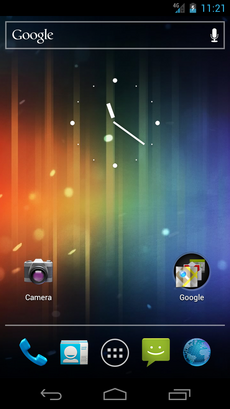 Android 4.0 home screen |
| 4.0.1 | October 19, 2011 |
| |
| 4.0.2 | November 28, 2011 |
| |
Android 4.0.3 Ice Cream Sandwich
| Android 4.0.3 Ice Cream Sandwich (API 15) | |||
|---|---|---|---|
| Version | Release date | Features | Image(s) |
| 4.0.3 | December 16, 2011[111] |
| |
| 4.0.4 | March 28, 2012 |
| |
Android 4.1 Jelly Bean
| Android 4.1 Jelly Bean (API 16) | |||
|---|---|---|---|
| Google announced Android 4.1 (Jelly Bean) at the Google I/O conference on June 27, 2012. Based on Linux kernel 3.0.31, Jelly Bean was an incremental update with the primary aim of improving the functionality and performance of the user interface. The performance improvement involved "Project Butter", which uses touch anticipation, triple buffering, extended vsync timing and a fixed frame rate of 60 fps to create a fluid and "buttery-smooth" UI.[114] Android 4.1 Jelly Bean was released to the Android Open Source Project on July 9, 2012,[115] and the Nexus 7 tablet, the first device to run Jelly Bean, was released on July 13, 2012. | |||
| Version | Release date | Features | Image(s) |
| 4.1 | July 9, 2012 |
|  Android 4.1 home screen |
| 4.1.1 | July 9, 2012[119] |
| |
| 4.1.2 | October 9, 2012[120] | ||
Android 4.2 Jelly Bean
| Android 4.2 Jelly Bean (API 17) | ||
|---|---|---|
| Google was expected to announce Jelly Bean 4.2 at an event in New York City on October 29, 2012, but the event was cancelled due to Hurricane Sandy.[123] Instead of rescheduling the live event, Google announced the new version with a press release, under the slogan "A new flavor of Jelly Bean". Jelly Bean 4.2 was based on Linux kernel 3.4.0, and debuted on Google's Nexus 4 and Nexus 10, which were released on November 13, 2012.[124][125] | ||
| Version | Release date | Features |
| 4.2 | November 13, 2012[126] |
|
| 4.2.1 | November 27, 2012[131][132] |
|
| 4.2.2 | February 11, 2013[134] |
|
Android 4.3 Jelly Bean
| Android 4.3 Jelly Bean (API 18) | ||
|---|---|---|
| Google released Jelly Bean 4.3 under the slogan "An even sweeter Jelly Bean" on July 24, 2013, during an event in San Francisco called "Breakfast with Sundar Pichai". Most Nexus devices received the update within a week, although the second-generation Nexus 7 tablet was the first device to officially ship with it.[136] A minor bug fix update was released on August 22, 2013.[137] | ||
| Version | Release date | Features |
| 4.3 | July 24, 2013[138] |
|
| 4.3.1 | October 3, 2013[147] |
|
Android 4.4 KitKat
| Android 4.4 KitKat (API 19) | |||
|---|---|---|---|
| Google announced Android 4.4 KitKat on September 3, 2013. Although initially under the "Key Lime Pie" ("KLP") codename, the name was changed because "very few people actually know the taste of a key lime pie."[149] Some technology bloggers also expected the "Key Lime Pie" release to be Android 5.[150] KitKat debuted on Google's Nexus 5 on October 31, 2013, and was optimized to run on a greater range of devices than earlier Android versions, having 512 MB of RAM as a recommended minimum; those improvements were known as "Project Svelte" internally at Google.[151] The required minimum amount of RAM available to Android is 340 MB, and all devices with less than 512 MB of RAM must report themselves as "low RAM" devices.[152] | |||
| Version | Release date | Features | Image(s) |
| 4.4 | October 31, 2013[153][154] |
|  Android 4.4 home screen |
| 4.4.1 | December 5, 2013[168][169] |
| |
| 4.4.2 | December 9, 2013[170] |
| |
| 4.4.3 | June 2, 2014[172][173] |
| |
| 4.4.4 | June 19, 2014[176] |
| |
Android 4.4W KitKat, with wearable extensions
| Android 4.4W KitKat, with wearable extensions (API 20) | ||
|---|---|---|
| On June 24, 2014, a version of Android KitKat exclusive to Android Wear devices was released. | ||
| Version | Release date | Features |
| 4.4W[178] | June 25, 2014[179] |
|
| 4.4W.1 | September 6, 2014[180] |
|
| 4.4W.2 | October 21, 2014[181] |
|
Android 5.0 Lollipop
| Android 5.0 Lollipop (API 21) | |||
|---|---|---|---|
| Android 5.0 "Lollipop" was unveiled under the codename "Android L" on June 25, 2014, during Google I/O. It became available as an official over-the-air (OTA) update on November 12, 2014, for select devices that run distributions of Android serviced by Google, including Nexus and Google Play edition devices. Its source code was made available on November 3, 2014.[182][183]Lollipop features a redesigned user interface built around a responsive design language referred to as "material design". Other changes include improvements to the notifications, which can be accessed from the lockscreen and displayed within applications as top-of-the-screen banners. Furthermore, Google made internal changes to the platform, with the Android Runtime (ART) officially replacing Dalvik for improved application performance, and with changes intended to improve and optimize battery usage, known internally as Project Volta.[184][185][186][187] | |||
| Version | Release date | Features | Image(s) |
| 5.0[188] | November 4, 2014[19] |
| 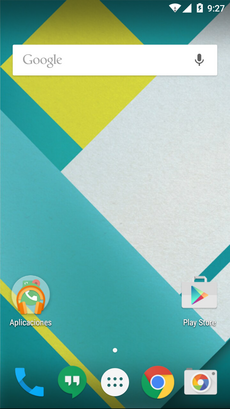 Android 5.0 home screen |
| 5.0.1 | December 2, 2014[202] |
| |
| 5.0.2 | December 19, 2014[24] |
| |
Android 5.1 Lollipop
| Android 5.1 Lollipop (API 22) | |||
|---|---|---|---|
| Version | Release date | Features | Image(s) |
| 5.1 | March 2, 2015[20] |
| |
| 5.1.1 | April 20, 2015[207][208] |
| 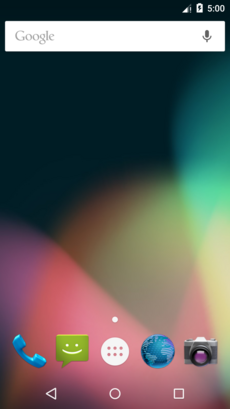 Screenshot of Android Lollipop (5.1.1) running on Google Nexus 5 (AVD Emulator) |
Android 6.0 Marshmallow
| Android 6.0 Marshmallow (API 23) | |||
|---|---|---|---|
| Android 6.0 "Marshmallow" was unveiled under the codename "Android M" during Google I/O on May 28, 2015, for the Nexus 5 and Nexus 6 phones, Nexus 9 tablet, and Nexus Player set-top box, under the build number MPZ44Q.[210] The third developer preview (MPA44G) was released on August 17, 2015, for the Nexus 5, Nexus 6, Nexus 9 and Nexus Player devices,[211] and was updated to MPA44I that brought fixes related to Android for Work profiles.[212] | |||
| Version | Release date | Features | Image(s) |
| 6.0 | September 29, 2015[21][213] |
|  Android 6.0 home screen |
| 6.0.1 | December 7, 2015[231] |
| |
Android 7.0 Nougat
| Android 7.0 Nougat (API 24) | |||
|---|---|---|---|
| Android "Nougat" (codenamed N in-development) is the seventh major release of the Android operating system. It was first released as a developer preview on March 9, 2016, with factory images for supported Nexus devices, as well as with the new "Android Beta Program" which allows supported devices to be upgraded directly to the Android Nougat beta via an over-the-air update. The final release was on August 22, 2016. The final preview build was released on July 18, 2016,[233] with the build number NPD90G. | |||
| Version | Release date | Features | Image(s) |
| 7.0 | August 22, 2016[234] |
| 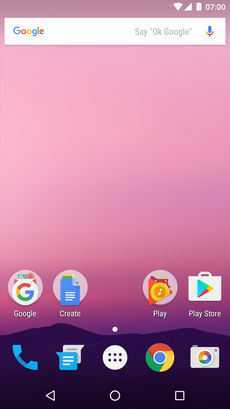 Android 7.0 home screen |
Android 7.1 Nougat
| Android 7.1 Nougat (API 25) | |||
|---|---|---|---|
| On October 19, 2016, Google released Android 7.1.1 as a developer preview for the Nexus 5X, Nexus 6P and the Pixel C. A second preview became available on November 22, 2016, before the final version was released to the public on December 5, 2016. | |||
| Version | Release date | Features | Image(s) |
| 7.1 | October 4, 2016[242] |
|  Android 7.1 home screen |
| 7.1.1[244] | December 1, 2016[245] |
| |
| 7.1.2[246][247] | April 2, 2017[248] |
| |
Android 8.0 Oreo
| Android 8.0 Oreo (API 26) | |||
|---|---|---|---|
| Android Oreo is the eighth major release of the Android operating system. It was first released as a developer preview, codenamed Android O, on March 21, 2017, with factory images for supported Nexus and Pixel devices. The final developer preview was released on July 24, 2017, with the stable version released in August 2017. | |||
| Version | Release date | Features | Image(s) |
| 8.0[249] | August 21, 2017 |
| Android 8.0 home screen |
Android 8.1 Oreo
| Android 8.1 Oreo (API 27) | |||
|---|---|---|---|
| Android 8.1 Oreo is the sixteenth minor release of the Android operating system. It was first released as a developer preview on October 25, 2017, with factory images for current Nexus and Pixel devices. A second developer preview was made available on November 27, 2017, for Nexus and Pixel devices, before the stable version was released on December 5, 2017. | |||
| Version | Release date | Features | Image(s) |
| 8.1[251][252] | December 5, 2017[253][254] |
|  Android 8.1 home screen |
Android 9 Pie
| Android 9 Pie (API 28) | |||
|---|---|---|---|
| Android Pie is the ninth major version of the Android operating system. It was first announced by Google on March 7, 2018, and the first developer preview was released on the same day. The second preview, considered beta quality, was released on May 8, 2018. The final beta of Android Pie (fifth preview, also considered as a "Release Candidate") was released on July 25, 2018. The first official release was released on August 6, 2018. | |||
| Version | Release date | Features | Image(s) |
| 9 | August 6, 2018 |
|  Android 9 home screen |
Android 10
| Android 10 (API 29) | |||
|---|---|---|---|
| Android 10 is the tenth major version of the Android operating system. The stable version of Android 10 was released on September 3, 2019. | |||
| Version | Release date | Features | Image(s) |
| 10 | September 3, 2019 |
| 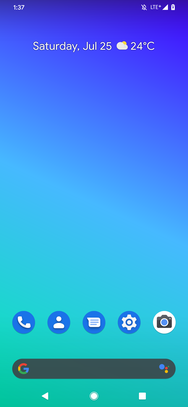 Android 10 home screen |
Android 11
| Android 11 (API 30) | |||
|---|---|---|---|
| Android 11 is the eleventh major version of the Android operating system. It was first announced by Google on February 19, 2020, and the first developer preview released on the same day.[276][277] The launch of Android 11 Beta was postponed from June 3, 2020, to June 10, 2020.[278] | |||
| Version | Release date | Features | Image(s) |
| 11 | September 8, 2020 |
| Android 11 home screen |
Android 12
| Android 12 (API 31) | |||
|---|---|---|---|
| Android 12 is the twelfth major version of the Android operating system. It was first announced by Google on February 18, 2021, and the first developer preview was released on the same day.[285][286] | |||
| Version | Release date | Features | Image(s) |
| 12 | October 4, 2021 |
| 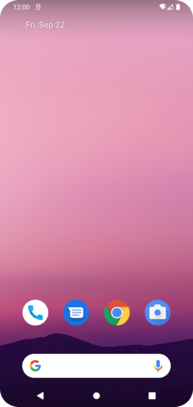 Android 12 home screen |
Android 12L
| Android 12L (API 32) | |||
|---|---|---|---|
| Android 12L[c] is an interim release for Android 12 that includes design tweaks for larger displays and minor stability changes to the operating system. It was announced on October 2021 alongside Beta releases with a stable version launching on March 7, 2022. | |||
| Version | Release date | Features | Image(s) |
| 12L | March 7, 2022 |
Improvements specific for foldable phones, tablets, desktop-sized screens and Chromebooks, and modifications to the user interface to tailor it to larger screens.[299] | |
Android 13
| Android 13 (API 33) | |||
|---|---|---|---|
| Android 13 is the thirteenth major version of the Android operating system. | |||
| Version | Release date | Features | Image(s) |
| 13 | August 15, 2022 |
| 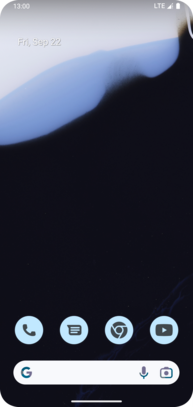 Android 13 home screen |
Android 14
| Android 14 (API 34) | |||
|---|---|---|---|
| Android 14 is the fourteenth major version of the Android operating system. Google announced Android 14 on February 8, 2023, with the first Developer Preview releasing on the same day. | |||
| Version | Release date | Features | Image(s) |
| 14 | October 4, 2023 |
| |
Android 15
| Android 15 (API 35) | |||
|---|---|---|---|
| Android 15 is the fifteenth major version of the Android operating system. | |||
| Version | Release date | Features | Image(s) |
| 15 | TBA |
| |